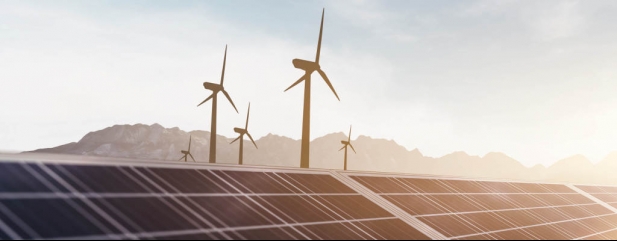Archived article
Please note that tax, investment, pension and ISA rules can change and the information and any views contained in this article may now be inaccurate.
Why renewable trusts trade at premiums despite patchy performance

There is no doubt that funds focused on ESG (environmental, social and governance) factors are still very popular, especially with younger investors, although the UK is still some way behind Europe on this score. A recent note from analysts at Liberum provides some details.
‘Investment flows into ESG funds not only outpace other equity fund styles including ETFs and index funds, but in fact outpace all other fund styles combined.
‘In the UK, ESG funds have seen net inflows between 2019 and mid-2021 of £20.4 billion, while the all other equity funds put together saw outflows of £6.8 billion’, report the analysts.

Meanwhile in Europe, they go on to say, between 2018 and the end of the first quarter of 2021 ESG funds saw inflows of €282.6 billion compared to net outflows of €142.8 billion for all other equity funds. Currently, less than 5% of all UK equity assets are managed by dedicated ESG funds against more than 14.4% in Europe.

ATTRACTIVE RETURNS
However, one area where the UK excels is in renewable energy infrastructure funds. According to the Association of Investment Companies, there are no fewer than 18 renewable infrastructure trusts managing a combined £12.4 billion in assets.
These combine the appeal of infrastructure investment – in other words real assets, which are a way of diversifying a portfolio away from the stock and bond markets – and renewable energy, which is a big growth area and has plenty of tailwinds.
Thanks to the high visibility of revenues, which are generally paid for out of government spending and are based on long-term contracts, renewable energy infrastructure returns are typically pretty stable.
Dividend yields are also much higher than 10-year or 20-year government bond yields and higher than those available in the wider market, thanks to contracts – and therefore income streams – being inflation-linked. According to analysts at Numis, the inflation linkage can be up to 65% of consumer price increases.
Two thirds of the funds are invested in power generation, with assets under management of just under £10 billion, while the other third invest in energy efficiency and storage systems and account for the balance of assets under management.
The sector is popular with income investors, thanks to yields of more than 5% for many investment companies, but many growth investors have also jumped into the sector this year on the back of expectations of juicy opportunities as the UK, Europe and the US ramp up government spending on ‘clean’ energy projects.
In addition to fundraises for existing trusts, five new companies have listed in the 12 months – Aquila Energy Efficiency Trust (AEET), Downing Renewables & Infrastructure Trust (DORE), Ecofin US Renewables Infrastructure Trust (RNEW), Triple Point Energy Efficiency Infrastructure (TEEC) and VH Global Sustainable Energy Opportunities (GSEO) – accounting for more than £650 million in new cash raised from investors.

LOSING THEIR APPEAL?
However, on average the sector has gone nowhere in 2021, with individual returns ranging from a gain of 9.4% this year in the case of SDCL Energy Efficiency Income Trust (SEIT) to a loss of 6.4% for the Aquila Energy Efficiency Trust (AEET) which floated in June.
If the performance of the iShares Global Clean Energy ETF (INRG) is anything to go by, it seems someinvestors have moved on. From 1 January the Clean Energy ETF has lost close to 20%, and from its high on 8 January the loss is more like 30%.
Yet – and this is what we really have trouble getting our head around – every trust bar one is trading at a premium to net asset value, even the ones that have performed poorly, with some stretching to double digits.
‘HOPE VALUE’
The arguments as to why the sector should trade at a premium to net asset value are that on the one hand the assets it represents – and the opportunities to invest in them – are scarce, while on the other the quality of their income streams means they deserve a premium rating.
To us, it looks as if there is an awful lot of ‘hope value’ in share prices, which is just as well as many of the trusts still need to raise cash to fund their investments as opportunities come up.
According to Priyesh Parmar and the investment trust team at Numis, renewable energy infrastructure funds gathered £1.2 billion of new money in the first half – including some of the new listings mentioned earlier – and some have continued to raise cash this quarter.
Disclaimer: The author Ian Conway owns shares in SDCL Energy Efficiency Income Trust
Important information:
These articles are provided by Shares magazine which is published by AJ Bell Media, a part of AJ Bell. Shares is not written by AJ Bell.
Shares is provided for your general information and use and is not a personal recommendation to invest. It is not intended to be relied upon by you in making or not making any investment decisions. The investments referred to in these articles will not be suitable for all investors. If in doubt please seek appropriate independent financial advice.
Investors acting on the information in these articles do so at their own risk and AJ Bell Media and its staff do not accept liability for losses suffered by investors as a result of their investment decisions.
Issue contents
Editor's View
Exchange-Traded Funds
Great Ideas
Investment Trusts
Money Matters
News
- Food ingredients giant picks London for IPO
- What BHP’s big news means for investors
- Wealth management could be answer to banks' profitability problem
- Private equity backed Zooplus could pressure Pets at Home
- Pandemic winners become re-opening losers as punters tune out
- Global M&A activity hits record levels, surpassing last year’s total

 magazine
magazine








